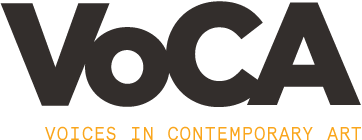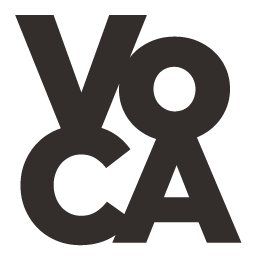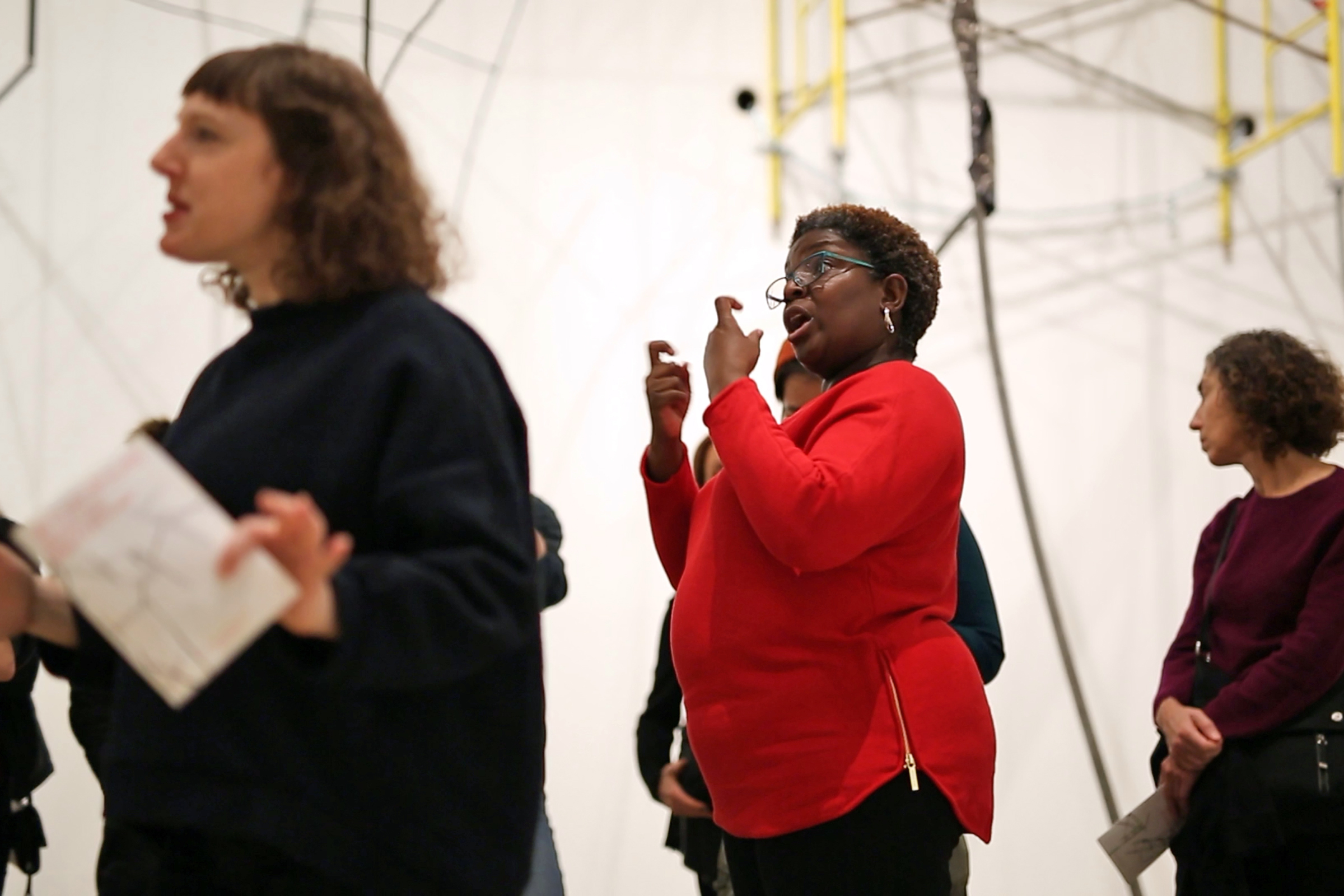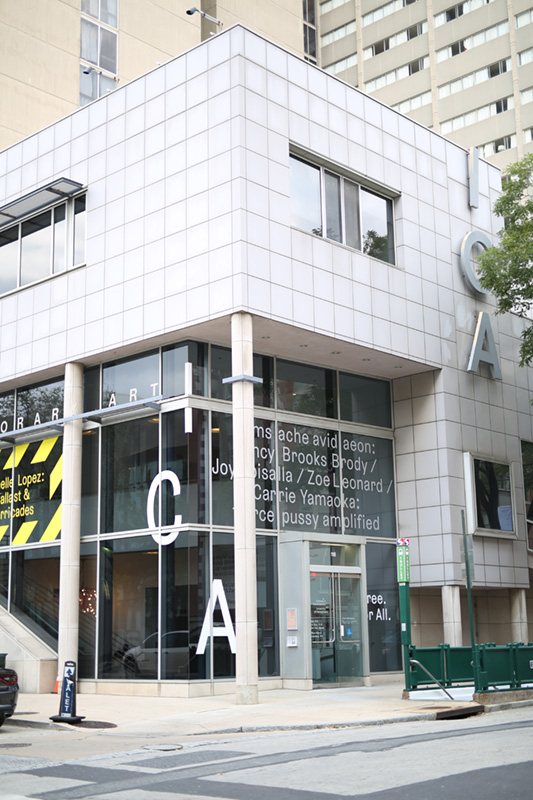Museums and the ADA at 30
A Case Study in Accessibility at ICA Philadelphia
In July of 2020, the United States marked the 30th anniversary of the passage of the Americans with Disabilities Act (ADA), prompting reflection on what has changed and what remains to be done to make the nation more inclusive and accessible. By reevaluating what accessibility means in museums, programs can be (re)designed to be more inclusive of our communities, including the more than 60 million adults in this country who have disabilities.
“Designing an accessible America—a vision still left unfulfilled—requires embedding design in systems that can support rights and equality in ways that go beyond the material.”1 So concludes Bess Williamson’s Accessible America: A History of Disability and Design (NYU Press, 2019). Williamson challenges disability studies to look beyond architectural features or tools, a challenge which can also be applied to an investigation of the social model of disability, as it applies to accessibility in museum spaces. With the 1990 passage of the ADA, public spaces and buildings became legally required to be physically accessible. Now, with the 30th anniversary of the ADA’s passage, art institutions should dig deeper, going “beyond the material” to investigate how our programmatic offerings can support the goals of access and inclusion.
Those words— “access” and “inclusion” —appear in many mission statements but are often left unfulfilled in practice. In this article, I use the American Alliance of Museums’ (AAM) definition of access: “Accessibility is giving equitable access to everyone along the continuum of human ability and experience. Accessibility encompasses the broader meanings of compliance and refers to how organizations make space for the characteristics that each person brings.”2 Institutions often turn to website redesigns, large print guides, or social narratives to boost accessibility. While all of these are meaningful steps in creating a well-rounded slate of offerings, they alone do not create an equitable experience for visitors with disabilities. By considering four pillars of creating and maintaining accessible programs— integration, connection, authenticity, and sustainability—we can reassess and foreground accessibility to not only benefit visitors with disabilities, but to better engage all visitors. Using the Institute of Contemporary Art at the University of Pennsylvania as a case study, I will explore how institutions can, with the help of an increased understanding of disability history, better their access programs and improve implementation of new accessibility-related initiatives.
Increasing accessibility has become central to museum planning across the board since the passage of the ADA. Institutions have taken infrastructural approaches such as adding ramps and improving didactics; but have also implemented programs with interpretation, or included low sensory days on their calendars—shifts which require budgetary and staffing measures. Recently, however, the goal of accessibility has taken on a new meaning. In 2019, the International Council on Museums (ICOM) updated the definition of a museum, stating that museums “are participatory and transparent, and work in active partnership with and for diverse communities to collect, preserve, research, interpret, exhibit and enhance understandings of the world, aiming to contribute to human dignity and social justice, global equality and planetary wellbeing.”3 This humanistic goal of museums existing to enhance connection and empathy is a massive undertaking, but when broken down into component parts, it begins to feel much more attainable. For example, many art museums offer opportunities for discussion, which can open new avenues of understanding. At its core, ICOM’s new definition centers around the idea of community. However, when institutions consider their communities, the disability community has often been overlooked.
The CDC estimates4 that about 25% of adults in the United States have some kind of disability.5 This equates to about 61 million individuals 18 or older. Yet, in the NEA’s 2017 Survey of Public Participation in the Arts, less than 7% of all adults attending performing arts events or visiting art museums/galleries have disabilities.6 The ADA dictates that “reasonable accommodation[s]” must be provided to individuals with disabilities, including things such as a “substantially equivalent”7 view for person who uses a wheelchair when at an event; or “effective communication”8 for someone who is blind or deaf. While all public institutions are required to meet these standards, we can do more than provide a good seat or converse with someone clearly. These requirements, particularly as they apply to programs rather than architecture, are very open-ended, which is why many activists and scholars “consider the legal requirements and design standards set by the ADA as merely the minimum standard.”9 There is room for growth to go above and beyond, which can help bring up that 7% figure.
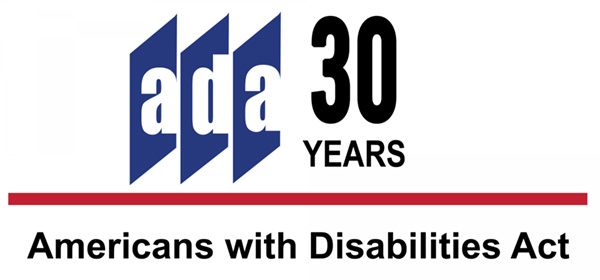
ADA 30th anniversary logo. The letters “ADA” appear in individual diamond-shaped blue panes, next to the text “30 years” stacked up in black. Beneath this text is a thick red line, and underneath that reads “Americans with Disabilities Act” in black. Image from: https://www.adaanniversary.org/
The Americans with Disabilities Act built upon decades of other legislation, such as the Architectural Barriers Act of 1968, the Rehabilitation Act of 1973, the Individuals with Disabilities Education Act (IDEA) of 1975, and even the 1964 Civil Rights Act. Much of the ADA focuses on enforcement of equitable offerings, which was groundbreaking at the time of its passage. The ADA was perhaps more groundbreaking for mandating that equal offerings are up to businesses, spaces, and institutions, not people with disabilities. In other words: it is up to society to better provide for everyone, not up to individuals with disabilities to make room for themselves in the world. Thus, the ADA marks the start of broader recognition of the social model of disability in the United States.10
At about 16%, Philadelphia has the highest rate of disability for any large city in the US, meaning more than 250,000 people that live here have some kind of disability.11 At the Institute of Contemporary Art (ICA) in Philadelphia, where I am the Program Coordinator and Co-Chair of the Accessibility Committee, our slogan is “Free. For all.” Starting in 2019, my colleagues and I dug into “for all” by taking a closer look at the museum’s accessibility offerings, understanding that this was an essential component of reaching our local community. This began with the creation of a cross-departmental Accessibility Committee, an internally-generated initiative led by staffers (both general and department directors), without a mandate from the Board. The ICA had previously had a similar committee which had dissolved a handful of years prior after a period of heavy staff turnover, but as we began our journey to deepen our accessible offerings, we recognized the need to reinstate a space where such initiatives could be communicated and supported across the museum. In the summer of 2019, a colleague—my Co-Chair, Elizabeth Chong, Visitor Services Coordinator—and I were interested in having ASL interpretation at some upcoming programs, as well as offering more pre-visit information on our website, so we convened a handful of staffers from around the museum to think through how we could make that happen. Elizabeth and I volunteered to lead the charge: we both had experience in accessibility work, and our roles are heavily public-facing at the institution. By September, we had 10 members from across the administrative, public engagement, marketing, and curatorial departments in a group which had formally become the Accessibility Committee. Committee meetings soon evolved into a platform for sharing resources and discussing our web presence, exhibitions, programs, and more, where non-committee staffers were always welcome to sit in. By February 2020, the committee had gained enough interest that the museum hosted a cultural accessibility training session for the entire full-time staff, put on by our local partner, Art-Reach.
At first, the committee focused on research and building relationships with organizations and individuals around Philadelphia, such as Art-Reach, the Deaf-Hearing Communication Center (DHCC), and a local autism advocate. We also spent time exploring initiatives at other museums around Philadelphia, such as the Mütter Museum and the Penn Museum. We found several opportunities for individuals who are blind or low vision, and many sensory-friendly programs, but saw a gap in programs for the Deaf community. This, the committee decided, would be an excellent place for us to start. We already had connections with DHCC, and knew of other people to whom we could reach out. We knew that there is an active and large Deaf community in Philadelphia.12 From there, we embarked on ICA’s first large-scale programmatic accessibility initiative: American Sign Language (ASL) interpretation at select events. Throughout the process of designing and implementing ASL programs, four themes arose as key concepts in creating effective programs. I have come to refer to these as the previously mentioned four pillars of accessibility: integration, authenticity, sustainability, and connection.

Illustration of a 2D building (blue), with 4 colored Ionic columns holding up the roof. The columns are yellow, red, green, and blue (left to right). Each column is overlaid with 1 of the 4 pillar words in black text. Left to right: “integration,” “sustainability,” “authenticity,” and “connection.” The roof of the building says “accessibility.” Image courtesy of the author
Integration is comprised of two parts: First, how does a new initiative (such as a website, program, etc.) fit in with pre-existing offerings? And second, are you merging communities, or siloing them? For ICA, this meant that, rather than creating an ASL-specific program, we wanted to add interpretation to a successful program that we were already doing. ICA is a non-collecting institution, so exhibitions change a few times per year. For each exhibition season, ICA hosts one curator-led tour for each show. Curator tours are a very popular signature program; they create space to take a deep dive into the art on view. Infrastructure was already in place for this program series, and it seemed that adding ASL would be a unique offering, since no one on the committee was aware of other institutions in Philadelphia that always provide ASL at this kind of tour. Plus, groups of people with different needs were being served effectively and simultaneously: no one was separated based on their dis/ability status. At the first ASL-interpreted curator tour, held in November of 2019, we had almost a 20% registration rate of individuals who said they would use the interpreter. By the second tour, that request rate had doubled.
The second pillar of accessibility is authenticity. One motto of the disability movement in the late-20th century was: “Nothing about us without us.” Authenticity means getting input and guidance from the community you are trying to reach. As we recall from ICOM’s latest museum definition, museums are here to “work in active partnership with and for diverse communities.” During the brainstorming phase, ICA’s committee members did this by reaching out to various organizations to start making connections. When programs for the Deaf/HoH community became the focus, we strengthened these connections by reaching out to new contacts like Hands UP Productions, who became ICA’s regular interpretation service at all ASL events. In addition, after every program that includes interpretation, the museum always makes a digital survey available for feedback. Alongside this, before we implemented the first tour, I began learning ASL. This not only gave me increased communication ability with our expanded pool of program attendees, but also embodied institutional commitment to bettering ICA’s accessibility.
Sustainability is the next pillar that supports accessibility. Museums constantly battle with their budgets, making choices about where to allocate money to best meet their goals and support their communities. This was a huge consideration as ICA began accessible programming: how will we maintain this long-term? ASL interpretation is guaranteed at every curator-led tour and is available upon request at other events. This choice was a way to work within a budget. The ICA simply does not have the funds to provide ASL at every single event. After seeing the overwhelmingly positive response to interpretation, the committee explored additional ways to engage this sector of the disability community, such as Communication Access Real-Time Translation (CART) captioning at major panels, and consistently providing transcripts or captioned videos of events on the website. These have been rolled out one step at a time and have needed adjustment along the way. We have learned to be reasonable about capacity, understanding that it is better to do a limited number of things well, than to offer a slate of semi-developed possibilities. At ICA, we can provide a digital social narrative, better website navigation, transcripts, some interpreted programs, large-print guides, and opportunities for feedback. As the accessibility journey continues, the goal is to do more, but to do it in a way that is sustainable, high-quality, and truly serves the communities that ICA is trying to reach.
The final essential pillar is connection. Connection is all about community: effectively reaching the goal audience and creating a network of support for the program. DHCC and Hands UP Productions have become integral supporters of ICA’s ASL work, from providing translation services to posting events on their calendars, websites, and newsletters. Our goal is to provide a positive learning experience that will make people want to come back. The individuals who have come back for multiple events—from people who are deaf to students learning to be ASL interpreters—have expanded and improved ICA’s community in an invaluable way.
The work that ICA is currently doing to engage Deaf and HoH communities can serve as a template for other institutions without massive overhauls or millions of dollars. Rather than creating separate access programs that silo individuals with disabilities, ICA integrates access into the fiber of preexisting programs. Rather than implementing a massive slate of ideas, we are working collaboratively and slowly—both internally, and across Philadelphia—to strengthen our connections and build a strong foundation in our process, as well as offerings. When considering the stewardship of contemporary art, a non-collecting museum such as the ICA that relies heavily on programs to bring in new visitors must work on redefining what it means to engage our community effectively. Art is meant to be experienced, which means engagement is part of its care and stewardship. In non-collecting institutions, it is especially essential to bring in visitors, put on programs that shift people’s point of view, and leverage the art to launch conversations. Access is an essential part of this consideration: museum professionals and institutions can be better stewards by welcoming more people with diverse experiences, needs, and abilities.
I believe, and have seen first-hand, that creating programs and initiatives that consider the four essential pillars of integration, sustainability, authenticity, and connection will make for greater accessibility, and longevity of accessible programs for art institutions. Making these considerations in advance creates the space to see potential sticking points and helps promote nimbleness when needed to adapt, or to take feedback into consideration. Such adaptability has been a key feature of institutions recently, as COVID-19 has impacted the world in 2020. For ICA, this has meant figuring out new ways to make digital programs accessible. Without the usual curator tours, another popular signature program, Mindfulness at the Museum, took a front seat in April and May. ICA was able to virtually interpret a program for the very first time at one such session, which was a great way to continue our sustainable engagement. Everything else remained the same: surveys were still offered via a link, Hands UP remained the contracted interpretation service, and space was made at the following Accessibility Committee meeting for reflection.

A screenshot of Brian from Hands UP Productions signing for a digital Mindfulness session via Zoom. Brian is large and central, wearing a dark blue sweater. 6 smaller Zoom screens (blacked out) of participants are above his image. Image courtesy of the ICA
Museums are places of education, not just for our publics, but for our staff, too. I think that this is particularly true for institutions connected to contemporary art. Working with living artists is all about communication, collaboration, and learning. What if we, as a field, approached accessibility with the same open-mindedness, and same willingness to stumble and try a few times before we get it right? Haben Girma, the first Deafblind graduate of Harvard Law School, says:
It’s okay not to have the answer, as long as you try. Try one solution. If that doesn’t work, try another… It all comes down to these small choices. What stories do we elevate? What do we believe about access and inclusion? These small choices make a huge difference. The dominant story of disability is that of challenge and overcoming. I believe that disability is about opportunities for innovation and growth.13
To me, art is about creativity, connection, and innovation. Museums, too, embody these traits, and will be stronger for creatively innovating to connect with new visitors, and include their full community potential. We can (and should!) think about access as more than a legally-mandated ramp, remembering that there is a difference between providing accommodations and working towards true inclusion. Museums can be on the forefront of championing this vital work. 2020 is the 30th anniversary of the Americans with Disabilities Act. A lot has changed in 30 years, but there is more work to be done. We must challenge ourselves to act so that, in another 30 years, art institutions and cultural laborers can pause to celebrate progress, before once again looking ahead at how to be better still.
References
1 Williamson, Bess. Accessible America: A History of Disability and Design (New York: NYU Press, 2019), 214.
2 “Definitions of Diversity, Equity, Accessibility, and Inclusion.” American Alliance of Museums. Accessed May 2020 from https://www.aam-us.org/programs/diversity-equity-accessibility-and-inclusion/facing-change-definitions/
3 Heal, Sharon. “The Policy Column: What Defines a Museum?” Museums Association Museums Journal online. 9 Feb 2019. https://www.museumsassociation.org/museums-journal/comment/02092019-policy-column
4 Interestingly, it is somewhat difficult to get an exact number because various surveys include different definitions of disability. Some sources may include intellectual disabilities, while others may only be bodily. Some may be broken down by age or other demographic. This estimate seems to be the most comprehensive figure. For more information on understanding disability data, see here: https://adata.org/factsheet/understanding-disability-statistics
5 “CDC: 1 in 4 US adults live with a disability.” Centers for Disease Control. Last updated 16 August 2018. https://www.cdc.gov/media/releases/2018/p0816-disability.html
6 “The 2017 Survey of Public Participation in the Arts.” National Endowment for the Arts. Last updated September 2018. https://www.arts.gov/impact/research/arts-data-profile-series/adp-18
7 “Proposed ADA Standards for Accessible Design.” ada.gov. Last updated 2005. https://www.ada.gov/archive/NPRM2008/ada_standards/proposedadastds.htm
8 “ADA Requirements: Effective Communication.” US Department of Justice, Disability Rights Section. Modified 15 September 2010. https://www.ada.gov/effective-comm.htm
9 Bienvenu, Beth. “Museums and ADA at 25: Progress and Looking Ahead” in Diversity, Equity, Accessibility, and Inclusion in Museums, ed. Johnnetta Betsch Cole and Laura L. Lott. (London: Rowman & Littlefield, 2019), 59.
10 The social model has roots as far as back as the mid-19th century, and became more common in the UK in the 1950s. However, as the US has a very “do-it-yourself” Western democratic model, the social model took much longer to gain awareness. A great resource to learn more on this evolution can be found here: https://www.nursingtimes.net/roles/learning-disability-nurses/how-the-social-model-of-disability-evolved-09-12-2014/
11 Tanenbaum, Michael. “Pew: Philadelphia has highest rate of disability among large U.S. cities.” Philly Voice. Published 17 July 2018. https://www.phillyvoice.com/pew-philadelphia-has-highest-rate-disability-among-large-us-cities/
12 “Disability Characteristics.” United States Census Bureau. Published in 2018. https://data.census.gov/cedsci/table?q=S1810&g=0100000US&tid=ACSST1Y2018.S1810
13 Girma, Haben. “Disability and Innovation: The Universal Benefits of Inclusive Design” in Diversity, Equity, Accessibility, and Inclusion in Museums, ed. Johnnetta Betsch Cole and Laura L. Lott. (London: Rowman & Littlefield, 2019), 103-4
Further Reading
Disability and Art History, ed. Ann Millett-Gallant and Elizabeth Howie (London: Routledge, 2017).
Kruppers, Petra. Studying Disability Arts and Culture: An Introduction (London: Palgrave Macmillan, 2014).
Nielsen, Kim E. A Disability History of the United States (Boston: Beacon Press, 2012).
The Ragged Edge: The Disability Experience from the Pages of the First Fifteen Years of The Disability Rag, ed. Barrett Shaw (Louisville: The Avocado Press, 1994).
Image description: Jackie from Hands UP Productions translating in American Sign Language for a tour led by curator Alex Klein at the ICA in December of 2019. Jackie, a medium dark-skinned person with short hair, is at the center of the image, wearing a bright red shirt and glasses with aquamarine frames. Her hands are raised to shoulder height and are turned inward toward her face, making a hook shape with each pointer finger. Alex is in the left foreground of the image, speaking to someone outside of the frame. She is a light-skinned female with brown shoulder-length hair and she wears a loose black sweater. She holds a white, printed gallery guide in her raised left hand.
